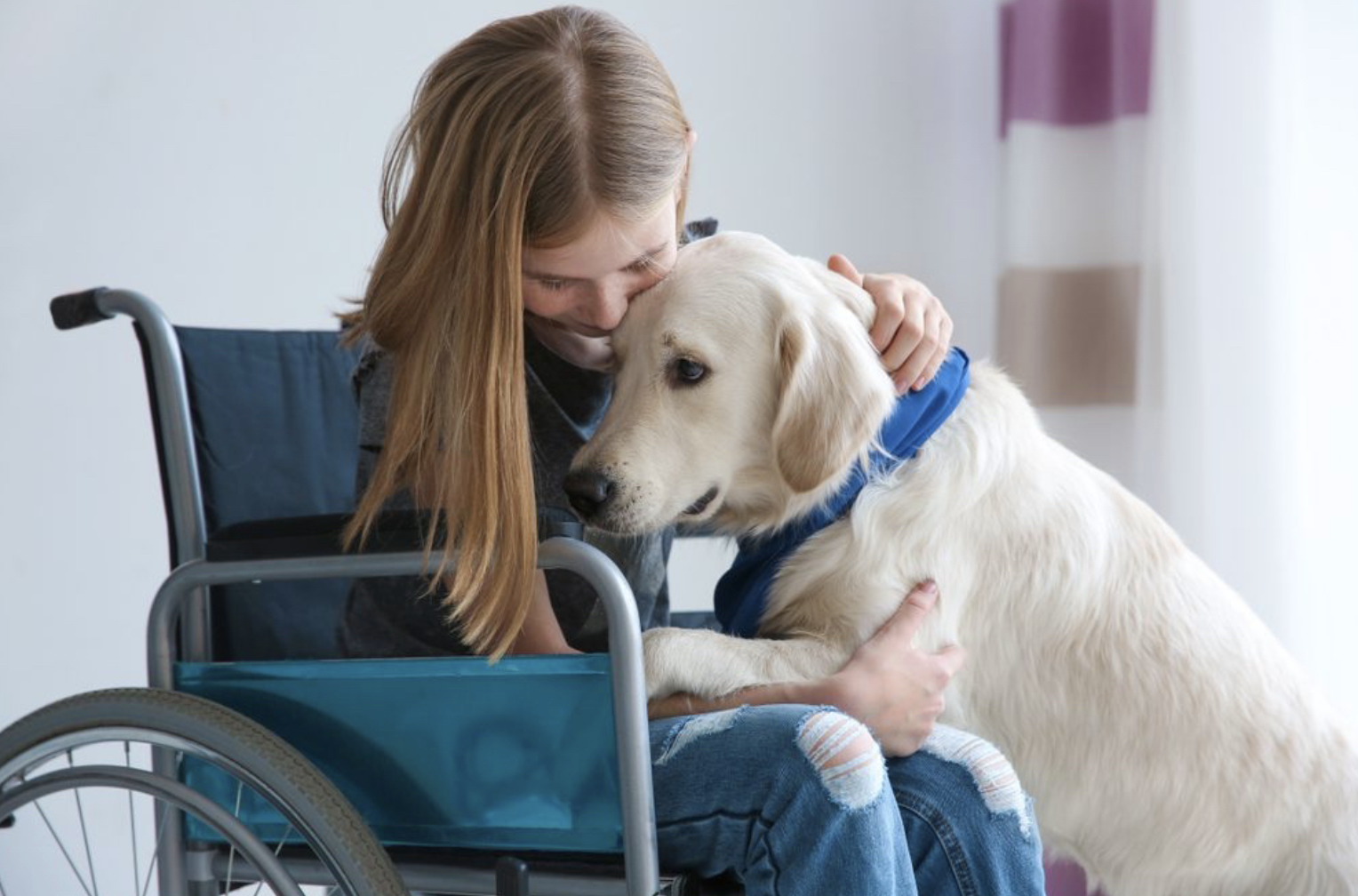- 1. Understanding Epilepsy
- 2. Seizure Alert Dogs Defined
- 3. The Extraordinary Canine Nose
- 4. Selecting the Right Candidate
- 5. Training Process and Techniques
- 6. Task Training for Seizure Alert Dogs
- 7. Legal Rights and Public Access
- 8. Life with a Seizure Alert Dog
- 9. Certification and Accreditation
- 10. Common Myths and Misconceptions
- 11. Training Support and Resources:
- 12. Real-Life Stories
- 13. The Future of Seizure Alert Dogs:
Epilepsy, a neurological disorder characterized by recurrent seizures, affects millions of people worldwide. These seizures can vary in intensity and frequency, often presenting challenges to the affected individuals' daily lives. In recent years, the remarkable abilities of seizure alert dogs have emerged as a potential solution, offering not only practical assistance but also emotional support. This comprehensive guide delves into the world of epilepsy and seizure alert dogs, exploring their role, training, benefits, and the life-changing impact they bring to those living with epilepsy.
1. Understanding Epilepsy
Exploring the Basics of Epilepsy
Epilepsy stands as one of the most prevalent neurological disorders globally, affecting individuals of all ages, backgrounds, and walks of life. It is characterized by the occurrence of recurrent seizures, which are essentially abnormal bursts of electrical activity in the brain. These seizures can manifest in various forms, ranging from subtle and barely noticeable to intense and convulsive. To better comprehend epilepsy and its impact, it's essential to delve into the fundamentals of this complex disorder.
Different Types of Seizures and Their Effects
Seizures, the hallmark of epilepsy, can be broadly classified into two main categories: generalized seizures and focal (partial) seizures.
Generalized Seizures: These seizures involve abnormal electrical activity that affects the entire brain from the outset. They can be further categorized into several subtypes:
1. Tonic-Clonic Seizures (Grand Mal): This is perhaps the most recognized seizure type. It consists of two phases—the tonic phase, characterized by muscle stiffness and loss of consciousness, followed by the clonic phase, marked by rhythmic jerking movements. Afterward, there's a period of confusion or sleepiness.
2. Absence Seizures (Petit Mal): These are brief lapses of consciousness lasting a few seconds. Individuals may appear momentarily "absent" or stare blankly. They usually resume normal activity without any memory of the episode.
3. Myoclonic Seizures: Myoclonic seizures manifest as sudden, brief muscle jerks that can affect a specific body part or the entire body. They often occur upon waking up or falling asleep.
4. Atonic Seizures: Also known as drop attacks, atonic seizures cause a sudden loss of muscle tone, resulting in a person collapsing or falling to the ground.
Focal (Partial) Seizures: Focal seizures originate in a specific area of the brain and can be further divided into two subtypes: focal onset aware seizures and focal onset impaired awareness seizures.
1. Focal Onset Aware Seizures (Simple Partial Seizures): During these seizures, an individual remains conscious and aware. They may experience unusual sensations, emotions, or movements. These sensations, known as auras, often act as a warning sign of an impending seizure.
2. Focal Onset Impaired Awareness Seizures (Complex Partial Seizures): These seizures lead to altered consciousness, and individuals may exhibit repetitive movements, wander, or appear confused. Memory loss of the event may occur.
The effects of seizures vary widely, ranging from momentary lapses in awareness to intense convulsions. Depending on the type of seizure and its severity, individuals may experience temporary confusion, memory gaps, fatigue, physical injury from falls, and emotional distress. Epilepsy's impact extends beyond the physical aspects, affecting various aspects of daily life, including employment, relationships, and overall quality of life.
As we delve deeper into the world of epilepsy and its interaction with the remarkable abilities of seizure alert dogs, it becomes evident that these canine companions offer more than just a practical solution—they provide a bridge of support, understanding, and empowerment for individuals navigating the challenges of living with epilepsy.
2. Seizure Alert Dogs Defined
Defining the Role of Seizure Alert Dogs
Seizure alert dogs are extraordinary service animals trained to provide timely and potentially life-saving assistance to individuals who experience seizures, particularly those with epilepsy. Their remarkable ability lies in their acute sense of smell, which allows them to detect subtle chemical changes in the body that occur before a seizure takes place. This early detection gives the handler valuable moments to prepare and seek a safe environment, reducing the risk of injury and ensuring a more controlled experience during the seizure event.
How Seizure Alert Dogs Differ from Other Service Dogs
While various types of service dogs offer specialized assistance, seizure alert dogs stand out due to their unique skill set:
1. Alerting Capability: Seizure alert dogs are specifically trained to detect and signal impending seizures, making them distinct from other service dogs that perform tasks like guiding individuals with visual impairments or providing mobility assistance.
2. Early Intervention: The ability of seizure alert dogs to provide early warnings contributes to minimizing risks associated with seizures, such as falls or accidents. This proactive approach sets them apart from traditional medical alert systems.
3. Olfactory Expertise: Seizure alert dogs harness their extraordinary sense of smell, which sets them apart from other service dogs that may rely on skills such as guiding, retrieving, or providing emotional support.
4. Intuitive Connection: The unique bond between a seizure alert dog and their handler is based on mutual trust and understanding. The dog's ability to detect changes in the handler's body chemistry fosters a close connection that extends beyond their alerting duties.
3. The Extraordinary Canine Nose
Unveiling the Olfactory Sensitivity of Dogs
Dogs have long been recognized for their remarkable olfactory abilities, often referred to as their superpower. Their sense of smell is not only immensely superior to that of humans but is also incredibly sophisticated, making them uniquely equipped to detect a wide range of scents, including those imperceptible to us. The olfactory system of dogs is a marvel of evolution, with intricate structures that allow them to perceive and interpret odors in ways that remain beyond human comprehension.
How Dogs Detect Chemical Changes Preceding Seizures
At the heart of a seizure alert dog's remarkable ability lies its unparalleled sense of smell. Scientific studies have shown that dogs can detect minute changes in the chemical composition of the air, body, or environment. This sensitivity is harnessed in the case of seizure alert dogs to detect specific odors emitted by the human body prior to the onset of a seizure.
The precise mechanisms by which dogs detect these changes are not fully understood, but there are several theories:
1. Chemical Changes: As seizures are accompanied by changes in brain activity, the body releases subtle chemical compounds that a dog's sensitive nose can pick up. These compounds may include hormones, pheromones, or other molecules produced during abnormal neural firing.
2. Electromagnetic Sensitivity: Some studies suggest that dogs are sensitive to the electromagnetic fields generated by neural activity. These fields may fluctuate before a seizure, serving as a potential indicator for alert dogs.
3. Behavioral Cues: In some cases, dogs may pick up on subtle behavioral cues or changes in a person's body language that occur before a seizure. These cues could be triggered by the body's physiological changes.
4. Selecting the Right Candidate
Ideal Candidates for Seizure Alert Dogs
The process of selecting an ideal candidate for a seizure alert dog involves a thoughtful assessment of both the individual's medical needs and the dog's suitability for training. While seizure alert dogs offer invaluable support, not everyone with epilepsy may require or benefit from their assistance. To ensure a successful partnership, it's important to consider the following factors when identifying potential candidates:
1. Frequency and Severity of Seizures: Individuals who experience frequent and unpredictable seizures are prime candidates for a seizure alert dog. These dogs can provide early warnings that help mitigate risks and improve safety.
2. Independence Goals: Candidates who seek greater independence and confidence in their daily lives, especially during activities that may carry higher risks during a seizure, can benefit significantly from a seizure alert dog's presence.
3. Lifestyle and Support System: Candidates with a stable and supportive living environment are better positioned to provide consistent care and attention to their seizure alert dog. The dog becomes an integral part of the household routine.
4. Commitment to Training: Successful integration of a seizure alert dog requires commitment to training and handling protocols. Candidates willing to invest time, effort, and patience in the training process are more likely to form a strong bond with their canine companion.
Considerations in Choosing a Dog for Training
Selecting the right dog for training as a seizure alert dog is equally vital. Not all dogs possess the necessary temperament, behavior, and sensory abilities for this specialized role. Here are some considerations to weigh when choosing a dog for training:
1. Breed and Size: While various breeds can excel as seizure alert dogs, some breeds exhibit heightened sensitivity and are more naturally attuned to changes in their environment. The dog's size should also be suitable for the individual's living situation.
2. Temperament: Dogs with a calm, attentive, and trainable temperament are best suited for training as seizure alert dogs. They should be social, responsive to commands, and eager to please.
3. Sensory Perception: A dog with an exceptional sense of smell is essential for detecting the subtle changes preceding a seizure. Breeds with proven olfactory prowess, such as certain retrievers and hounds, are often preferred.
4. Health and Longevity: The dog's overall health and lifespan are crucial considerations. A healthy dog can provide consistent support over many years, enhancing the handler's quality of life.
5. Compatibility: The compatibility between the individual and the dog is a fundamental aspect. Personalities should mesh well, and the dog's presence should bring comfort and a sense of security.
5. Training Process and Techniques
The Fundamentals of Training Seizure Alert Dogs
The journey of transforming a dog into a skilled and reliable seizure alert companion is a remarkable blend of science, dedication, and the unique bond between humans and dogs. Training seizure alert dogs involves a combination of understanding canine behavior, utilizing positive reinforcement techniques, and capitalizing on their innate abilities. Here's an overview of the fundamental aspects of training these exceptional canines:
1. Understanding Canine Behavior: A solid grasp of canine behavior is the foundation of effective training. Handlers and trainers need to comprehend how dogs learn, communicate, and respond to various stimuli. This knowledge guides the training process and helps create a positive learning experience for both the dog and the handler.
2. Positive Reinforcement: Positive reinforcement is a cornerstone of training seizure alert dogs. This method involves rewarding desired behaviors with treats, praise, or toys, reinforcing the dog's understanding of the behavior's value. Positive reinforcement fosters a strong bond between the dog and the handler and encourages consistent performance of the alerting behavior.
3. Consistency and Repetition: Training is a gradual process that requires patience and repetition. Consistency in commands, rewards, and routines helps the dog associate specific behaviors with positive outcomes. Repetition solidifies learning and strengthens the neural connections responsible for alerting behaviors.
4. Task Isolation: Training is broken down into manageable steps, with each step building upon the previous one. Task isolation involves focusing on one specific aspect of the alert behavior before combining it with other cues. For example, isolating the scent associated with seizures helps the dog differentiate it from other scents.
Shaping Alert Behaviors: Positive Reinforcement Methods
Shaping alert behaviors in seizure alert dogs is a strategic process that leverages positive reinforcement methods to teach the dog to recognize and respond to the scent changes preceding a seizure. Here's an overview of how positive reinforcement is applied to shape these behaviors:
1. Scent Introduction: The dog is introduced to the scent associated with the individual's seizures. Positive reinforcement, such as treats or play, is paired with the scent exposure to create a positive association.
2. Alert Response: When the dog shows interest or a reaction to the scent, even if subtle, it's rewarded with treats and praise. This reinforces the connection between the scent and the positive outcome.
3. Confirmation Training: As the dog's reactions become more consistent, the handler introduces a cue, such as a specific command or signal, to prompt the alert behavior. When the dog responds correctly, it's rewarded.
4. Gradual Refinement: Over time, the dog's alert behavior is shaped and refined through repeated exposures and reinforcement. The dog learns to distinguish the target scent from other scents and to provide a clear, consistent alert signal.
5. Real-Life Scenarios: Training extends to real-life situations where the dog practices alerting behaviors in various environments. This helps the dog generalize its alerting skills beyond controlled training settings.
Positive reinforcement not only effectively teaches the dog the desired alert behavior but also enhances the bond between the dog and the handler. It creates a positive and enjoyable learning experience for the dog, motivating it to consistently perform the alerting task. Through careful training and the application of positive reinforcement techniques, seizure alert dogs become skilled and intuitive companions, offering invaluable support to individuals with epilepsy.
6. Task Training for Seizure Alert Dogs
Specific Tasks Seizure Alert Dogs Perform
The training of seizure alert dogs extends beyond their ability to detect changes in scent; these remarkable canines are also trained to perform specific tasks that enhance safety and independence for individuals with epilepsy. These tasks are carefully selected based on the individual's needs and the potential risks associated with their seizures. Here are some specific tasks that seizure alert dogs can be trained to perform:
1. Providing Early Warning: The core task of a seizure alert dog is to provide an early warning before a seizure occurs. This can involve behaviors such as nudging, pawing, or alerting the handler in a specific way to signal an impending seizure.
2. Guiding to a Safe Place: Seizure alert dogs can guide their handlers to a safe location before a seizure begins, minimizing the risk of injury from falling or other hazards.
3. Alerting Caregivers: Some seizure alert dogs are trained to seek help or alert caregivers when their handler is in distress. This could involve activating an emergency button or finding a specific person.
4. Retrieving Medication: In cases where the individual requires medication during or after a seizure, the dog can be trained to retrieve medication and deliver it to the handler or a caregiver.
5. Providing Physical Support: Seizure alert dogs can offer physical support during or after a seizure, helping the individual maintain balance and prevent falls.
Enhancing Safety and Independence Through Training
The training process not only equips seizure alert dogs with the skills to perform specific tasks but also empowers individuals with epilepsy to live more confidently and independently. By relying on the dog's alerting abilities and trained tasks, handlers gain a renewed sense of control over their lives. Here's how training enhances safety and independence:
1. Timely Intervention: The early warning provided by seizure alert dogs allows handlers to take timely action, such as finding a safe place to sit or lie down, taking medication, or alerting someone for assistance.
2. Reduced Isolation: Individuals with epilepsy often face social isolation due to safety concerns. Seizure alert dogs mitigate these fears, enabling handlers to engage in social activities with increased confidence.
3. Lowered Anxiety: Knowing that a seizure alert dog is by their side offers emotional reassurance and reduces anxiety, as handlers are aware they have a companion that will alert and support them.
4. Empowerment: The tasks performed by seizure alert dogs give handlers a greater sense of independence, enabling them to navigate daily life with fewer limitations.
5. Emergency Assistance: In critical situations, seizure alert dogs can alert caregivers, medical professionals, or even emergency services, ensuring rapid response and necessary assistance.
7. Legal Rights and Public Access
Understanding Legal Protections for Service Dog Users
For individuals with disabilities, the presence of a service dog is more than just companionship; it's a lifeline that enables them to navigate the world with greater ease and independence. Recognizing the invaluable support these dogs provide, various laws have been enacted to ensure that service dog users are granted the legal rights and protections they deserve.
The rights and responsibilities of service dog users under the law are clear, but navigating public spaces and accommodations can still present challenges. Here are some key points to keep in mind:
1. No Discrimination: Businesses and public entities cannot discriminate against service dog users based on their disability or the presence of the service dog. This includes providing equal access to facilities and services.
2. Verification Not Required: Service dog users are not required to provide proof of their disability or the dog's training. Businesses can only ask two questions: whether the dog is a service animal required because of a disability and what tasks the dog is trained to perform.
3. Control and Behavior: Service dogs must be under control at all times. If a service dog behaves aggressively, is not housebroken, or poses a direct threat to others, the business or entity may ask the handler to remove the dog.
4. Public Spaces: Service dogs are allowed in public spaces, including restaurants, stores, parks, and public transportation. They are also permitted in areas where other animals might be restricted, such as housing that has a "no pets" policy.
5. Housing: Individuals with disabilities who require a service dog are protected by the ADA's housing provisions. Housing providers are required to make reasonable accommodations to allow individuals to live with their service dogs.
8. Life with a Seizure Alert Dog
Daily Impact and Improved Quality of Life
For individuals with epilepsy, each day can bring unpredictability and challenges. Seizure alert dogs step into this dynamic, offering support that transcends their training. These dogs empower their handlers to face daily life with greater confidence, knowing that they have a vigilant companion who will provide early warnings and assistance when needed.
Beyond their alerting capabilities, seizure alert dogs can help their handlers manage tasks that might otherwise be daunting. This might include guiding the individual through crowded spaces, retrieving essential items, and even acting as a calming presence during stressful moments.
The presence of a seizure alert dog significantly enhances safety by providing advanced warnings of impending seizures. This timely alerting gives handlers the precious seconds they need to find a safe spot, take medication, or alert someone nearby. As a result, the risk of injury during seizures is reduced, and handlers experience a heightened sense of security.
The Emotional Bond Between Handlers and Their Dogs
The bond between a seizure alert dog and their handler is truly remarkable. This partnership goes beyond the practical tasks the dog performs; it's a relationship characterized by mutual reliance and an unbreakable emotional connection. Here's why the bond between handlers and their seizure alert dogs is so profound:
1. Trust and Dependability: Seizure alert dogs become an integral part of their handler's support system. The dog's ability to provide early warnings and assistance creates a deep sense of trust and reliance.
2. Empathy and Connection: Seizure alert dogs exhibit a remarkable ability to sense their handler's emotional and physical state. They can provide comfort during moments of distress and offer an understanding presence that words cannot convey.
3. Shared Experiences: Handlers and their dogs share unique experiences that create a strong emotional bond. From training milestones to everyday moments, these shared memories deepen the connection between them.
4. Unconditional Acceptance: Seizure alert dogs offer unwavering acceptance and love. They do not judge or question; instead, they provide a safe space where handlers can be themselves.
The emotional bond between handlers and their seizure alert dogs enriches both lives in immeasurable ways. These dogs are not just assistants; they are confidantes, allies, and sources of joy.
9. Certification and Accreditation
Recognized Organizations and Standards
The world of service dogs, including seizure alert dogs, operates within a framework of standards and certifications designed to ensure the reliability, training, and effectiveness of these remarkable canine companions. This certification and accreditation process not only validates the skills of the dogs but also provides assurance to handlers and the public. Let's explore the critical aspects of certification and accreditation in the context of seizure alert dogs.
Certification and accreditation offer numerous benefits to handlers, trainers, and the public:
1. Confidence: Handlers can trust that their seizure alert dog has undergone rigorous training and evaluation, enhancing their confidence in the dog's capabilities.
2. Public Recognition: A certified seizure alert dog is more likely to be welcomed in public spaces due to its recognized training and behavior standards.
3. Professionalism: Certified trainers adhere to ethical training practices, promoting the welfare of both dogs and handlers.
4. Trust: The public can trust that certified seizure alert dogs have been assessed for their ability to perform essential tasks reliably.
5. Advocacy: Certified seizure alert dogs contribute to the broader advocacy efforts for service dog rights and recognition.
Validating the Qualifications of Seizure Alert Dogs
Several reputable organizations specialize in training and certifying service dogs, including those with seizure alert capabilities. These organizations adhere to stringent standards, ensuring that the dogs meet specific criteria for behavior, skills, and training. They play a pivotal role in the selection, training, and assessment of seizure alert dogs.
Accreditation and Standards: Meeting Criteria
Accreditation bodies establish comprehensive standards that seizure alert dogs and their trainers must meet. These standards encompass various aspects of training, behavior, and suitability for service. Some key areas of focus include:
1. Behavioral Temperament: Seizure alert dogs must demonstrate calm and steady behavior in various environments. They should be non-aggressive, confident, and able to remain focused on their handler's needs.
2. Task Proficiency: Certification processes often require that seizure alert dogs perform their designated tasks consistently and reliably. This can involve simulating seizure scenarios to evaluate the dog's response.
3. Public Access Skills: Seizure alert dogs need to navigate public spaces with impeccable behavior. This includes remaining calm around distractions, not interfering with other people or dogs, and responding to their handler's commands.
4. Handler Skills: Handlers are also evaluated on their ability to effectively communicate and manage their seizure alert dogs. This ensures a harmonious partnership that benefits both the dog and the handler.
10. Common Myths and Misconceptions
The world of service dogs, particularly seizure alert dogs, is often shrouded in myths and misconceptions. These misunderstandings can stem from lack of awareness, misinformation, or a general unfamiliarity with the capabilities and roles of these remarkable canine companions. Let's address and debunk some of the most common myths surrounding seizure alert dogs, separating fact from fiction.
Myth 1: Seizure Alert Dogs Can Predict Seizures with Absolute Accuracy
Fact: While seizure alert dogs are known for their remarkable ability to detect changes in their handler's scent or behavior preceding a seizure, they are not infallible predictors. Their accuracy can vary, and there are instances where a seizure might occur without any prior indication from the dog. Seizure alert dogs significantly enhance safety by providing advanced warnings, but they are not a guarantee of preventing every seizure.
Myth 2: Seizure Alert Dogs Are Trained to Perform Medical Interventions
Fact: Seizure alert dogs are trained to provide early warnings and assistance, but they are not medical professionals. They do not administer medication or perform medical interventions. Their primary role is to alert their handler and potentially perform specific tasks to mitigate the impact of the seizure.
Myth 3: Any Dog Can Be Trained as a Seizure Alert Dog
Fact: While many dogs exhibit remarkable abilities, not every dog is suitable for becoming a seizure alert dog. The selection process involves evaluating the dog's temperament, behavior, and sensitivity to scent changes. Additionally, the training requires expertise and specialized techniques to ensure the dog's effectiveness.
Myth 4: Seizure Alert Dogs Are Always Large Breeds
Fact: The effectiveness of a seizure alert dog is not solely determined by its size or breed. Dogs of various sizes and breeds can excel as seizure alert dogs, as long as they meet the necessary behavioral and training criteria. The most critical factors are the dog's sensitivity to scent changes and its ability to perform tasks reliably.
Myth 5: Seizure Alert Dogs Are Just Like Emotional Support Animals (ESAs)
Fact: Seizure alert dogs serve a specific purpose—detecting and alerting to seizures. While they do offer emotional support, their role extends beyond providing comfort. Seizure alert dogs undergo specialized training to perform tasks that can prevent injuries during seizures and enhance safety for their handlers.
Myth 6: Seizure Alert Dogs Can Replace Medication
Fact: Seizure alert dogs are not a substitute for medical treatment or medication. They complement medical interventions by providing early warnings and assistance. Individuals with epilepsy should continue to follow their medical treatment plans and consult their healthcare providers.
Myth 7: Seizure Alert Dogs Are Aggressive or Dangerous
Fact: Seizure alert dogs are trained to remain calm, non-aggressive, and focused on their handler's needs. They are not trained to be aggressive toward people or other animals. In fact, aggressive behavior would disqualify a dog from becoming a seizure alert dog.
By dispelling these myths and misconceptions, we can foster a better understanding of the role, capabilities, and limitations of seizure alert dogs. These dogs, through their training, dedication, and companionship, play a pivotal role in enhancing the lives of individuals with epilepsy and raising awareness about the importance of service dogs.
11. Training Support and Resources:
Resources for Training Seizure Alert Dogs
The journey of training a seizure alert dog is a collaborative effort that involves dedication, expertise, and access to reliable resources. While the process can be complex, the availability of training support and resources can greatly facilitate the training of these remarkable canine companions. Let's explore the various resources that can aid in the training of seizure alert dogs.
1. Online Training Materials: The digital age has brought a wealth of training materials right to our fingertips. Online resources, including videos, tutorials, and training guides, can provide step-by-step instructions for teaching specific tasks and behaviors to seizure alert dogs.
2. Books and Publications: Many reputable authors have penned books dedicated to the training of service dogs, including seizure alert dogs. These books often cover a range of topics, from basic obedience to specialized tasks and techniques.
3. Service Dog Organizations: Recognized service dog organizations often provide educational resources and training guides for various types of service dogs, including seizure alert dogs. These resources can offer insights into best practices, training protocols, and task training.
4. Trainer Networks: Joining online communities or forums dedicated to service dog training can connect handlers with experienced trainers and fellow handlers. These networks offer a platform for sharing experiences, asking questions, and seeking advice.
5. Professional Trainers and Training Schools: One of the most valuable resources for training seizure alert dogs is enlisting the expertise of professional trainers and accredited training schools. These trainers specialize in service dog training and have experience with various types of tasks, including seizure alerting.
Service Dog Training School's Online Seizure Alert Service Dog Training Course:
1. Expertise: Accredited training schools offer specialized courses designed to train seizure alert dogs effectively. These courses are developed by experts who understand the intricacies of seizure alert training.
2. Comprehensive Curriculum: The online course covers a comprehensive curriculum that includes foundational obedience training, scent detection techniques, alerting behaviors, and public access skills.
3. Structured Learning: The online training course provides a structured learning environment, guiding handlers through each phase of training. Video demonstrations, step-by-step instructions, and assignments ensure a thorough understanding of the training process.
4. Ongoing Support: Enrolling in the online course provides access to professional trainers who offer ongoing support. Handlers can seek guidance, ask questions, and receive feedback on their training progress.
5. Flexibility: Online training courses offer the flexibility to learn at one's own pace, making it ideal for individuals with busy schedules. Handlers can access the course materials from the comfort of their homes.
As handlers embark on the journey of training a seizure alert dog, they have a range of resources at their disposal to ensure success. From online guides to the expertise of professional trainers, the Service Dog Training School's Online Seizure Alert Service Dog Training Course stands out as a comprehensive and accessible option for those seeking to train their seizure alert dogs effectively. This course not only imparts knowledge but also provides the practical skills needed to create a strong and reliable partnership between handlers and their seizure alert dogs.
12. Real-Life Stories
Inspiring Stories of Individuals Benefiting from Seizure Alert Dogs
Behind the training and dedication that goes into preparing seizure alert dogs are real-life stories that exemplify the transformative impact these canine companions can have on the lives of individuals with epilepsy. These stories reflect not only the extraordinary abilities of seizure alert dogs but also the profound emotional and practical support they provide to their handlers.
Personal Accounts of Positive Change and Empowerment:
1. Emma's Newfound Independence: Emma, a young woman living with epilepsy, found her life profoundly changed after partnering with a seizure alert dog named Luna. Previously, Emma experienced anxiety and uncertainty due to her unpredictable seizures. With Luna by her side, she gained newfound independence and confidence. Luna's ability to provide early warnings allowed Emma to navigate her daily activities with more assurance and a reduced fear of seizures catching her off guard.
2. Mark's Enhanced Quality of Life: Mark's journey with epilepsy led him to search for solutions that could improve his quality of life. After partnering with a trained seizure alert dog named Max, Mark experienced a remarkable transformation. Max's ability to sense seizures allowed Mark to engage in activities he once avoided, such as hiking and attending social gatherings. Mark's bond with Max extended beyond seizure alerts; Max became a loyal friend who provided emotional support during challenging moments.
3. Sarah's Empowerment: Sarah, a college student managing epilepsy, faced the obstacle of attending classes while dealing with seizures. Her seizure alert dog, Bailey, not only offered early warnings but also became a bridge to social interactions. Bailey's presence opened doors for conversations and connections, leading to a more inclusive college experience for Sarah.
4. Tom's Journey to Independence: Tom, an individual who had been dependent on caregivers due to frequent seizures, discovered a path to independence through his seizure alert dog, Rocky. Rocky's ability to predict seizures allowed Tom to engage in daily activities with reduced risk. This newfound independence empowered Tom to regain control over his life and pursue his passions with renewed determination.
5. Lisa's Emotional Support: Lisa's journey with epilepsy involved emotional ups and downs. Her seizure alert dog, Bella, provided not only physical assistance but also emotional grounding. Bella's companionship and unwavering support helped Lisa manage anxiety and stress, creating a more balanced and positive outlook on life.
These stories of individuals and their seizure alert dogs showcase the profound impact these canine partners have on emotional well-being, social engagement, and daily activities. Each story highlights the unique bond between handlers and their dogs, emphasizing the crucial role seizure alert dogs play in enhancing the lives of those with epilepsy. Through their incredible abilities and unwavering companionship, seizure alert dogs offer more than just alerts; they offer a path to empowerment, independence, and a brighter future for individuals living with epilepsy.
13. The Future of Seizure Alert Dogs:
As the field of assistance animals continues to evolve, the future of seizure alert dogs holds promise for both individuals with epilepsy and the broader medical community. Ongoing research, advancements in technology, and a deeper understanding of canine capabilities are shaping the trajectory of seizure alert dogs and their potential impact on epilepsy management.
Ongoing Research and Advancements:
1. Canine Scent Detection Studies: Ongoing research is delving into the intricate olfactory abilities of dogs and their potential to detect a wider range of chemical changes associated with seizures. These studies aim to refine the training techniques for seizure alert dogs, improving their accuracy in predicting seizures and extending their early warning capabilities.
2. Collaboration with Medical Professionals: Collaborative efforts between veterinary experts, neurologists, and epilepsy specialists are becoming more prevalent. This interdisciplinary approach seeks to integrate seizure alert dogs into comprehensive epilepsy management plans, creating a holistic approach that benefits individuals with epilepsy.
3. Technology Integration: Advancements in technology, such as wearable devices and smartphone apps, are being explored to enhance the capabilities of seizure alert dogs. These tools could work in tandem with the dogs' natural abilities, providing additional layers of early detection and alerts for seizures.
4. Training Techniques: Researchers are continually refining training techniques to optimize the development of seizure alert dogs. By incorporating the latest insights from behavioral science and canine psychology, trainers are working to ensure that seizure alert dogs consistently deliver reliable and accurate alerts.
Potential Impact on Epilepsy Management:
1. Early Intervention and Treatment: Seizure alert dogs have the potential to revolutionize epilepsy management by providing early warnings. Early alerts can facilitate timely intervention, enabling individuals with epilepsy to take preventive measures or seek medical attention before a seizure occurs.
2. Quality of Life Improvement: As the capabilities of seizure alert dogs improve, individuals living with epilepsy can experience a significant improvement in their overall quality of life. The assurance of having a dedicated companion that can predict seizures fosters a sense of security, independence, and confidence.
3. Reducing Hospitalizations: With the ability to predict seizures, seizure alert dogs have the potential to reduce the frequency of hospitalizations related to unanticipated seizures. This not only contributes to cost savings but also minimizes disruptions to daily life.
4. Emotional Well-Being: The companionship and emotional support provided by seizure alert dogs have a positive impact on the emotional well-being of individuals with epilepsy. The bond between a handler and their dog can alleviate feelings of isolation and anxiety, enhancing mental and emotional resilience.
5. Public Awareness and Acceptance: As more success stories emerge and the capabilities of seizure alert dogs become more recognized, public awareness and acceptance of these canine partners are likely to increase. This heightened awareness can lead to greater inclusivity and understanding within communities.
The future of seizure alert dogs holds exciting possibilities that extend beyond their current roles. As research and advancements continue to shape their capabilities, seizure alert dogs are poised to play an even more integral role in epilepsy management. By harnessing the remarkable olfactory senses of dogs and integrating them with modern technology and medical expertise, these canine companions are advancing the boundaries of epilepsy care, improving the lives of countless individuals and redefining what is possible in assistance animal support.
In conclusion, the integration of seizure alert dogs into the lives of individuals with epilepsy has the potential to transform how seizures are managed and experienced. These exceptional canine companions not only provide practical assistance but also offer companionship, emotional support, and a renewed sense of freedom. As the understanding of epilepsy continues to evolve, so does the role of seizure alert dogs in promoting independence and improving the overall well-being of those living with this condition.













